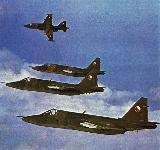Фотографии
-
The latest commercial version of the compact Kamov Ka-32 helicopter to be revealed in the Soviet Union is the Ka-32S illustrated here. Assigned the reporting name Helix in the West and now widely used by the Soviet Navy for ASW, SAR and target acquisition duties, the Ka-32 was shown in the West for the first time at the recent Paris Air Show. Unlike the standard civil Ka-32 exhibited at Le Bourget, the Ka-32S has a search radar beneath the nose, the "S" suffix appended to the designation signifying a dedicated SAR and aeromedical role. Powered by two 2,205 shp Isotov TV3- 117V turboshafts, the Ka-32S has normal and maximum loaded weights of 24.250 lb (11 000 kg) and 27,777 lb (12 600 kg). Maximum and cruising speeds; are 155 mph (250 km/h) and 143 mph (230 km/h) respectively, and maximum range and endurance are 497 mis (800 km) and 4-5 hours. Rotor diameter is 52-16 ft (15,90m) and fuselage length is 37-07 ft (11.30m).
Самолёты на фотографии: Камов Ка-32 - Россия - 1980
-
This newly-released DoD impression of the MiG-29 Fulcrum differs in a number of respects from previous illustrations of this single-seat counterair fighter. The principal differences are to be seen in the position of the wing, which appears to be mounted appreciably lower on the fuselage than believed hitherto, and in the relationship between the vertical tail surfaces and the engine tailpipes. It would seem from this impression that the tail surfaces are carried by lateral fairings extending along the fuselage from the wing trailing edge.
Самолёты на фотографии: МиГ МиГ-29 - Россия - 1977
-
Самолёты на фотографии: Сухой Су-25 Грач - Россия - 1975
-
Having now seen three years of operational service in Afghanistan, the Su-25 Frogfoot close air support aircraft is being more extensively deployed by the Soviet Air Forces and is also being supplied to other WarPac members, the first recipient being Czechoslovakia which received this type last year. An Su-25 in Czechoslovak service is seen here.
Самолёты на фотографии: Сухой Су-25 Грач - Россия - 1975
-
The photograph of the Su-25 Frogfoot show the fifth smaller wing pylon outboard which it may be assumed is intended to carry Atoll IR missiles for self-defence.
Самолёты на фотографии: Сухой Су-25 Грач - Россия - 1975
-
The photograph shows clearly the somewhat complex levered-suspension, narrow-track undercarriage with low-pressure tyres, the laser ranger in the nose and the 30-mm cannon in the portside of the forward fuselage. It may be assumed that, as with virtually all Soviet single-seat combat aircraft, a two-seat variant exists for conversion training.
Самолёты на фотографии: Сухой Су-25 Грач - Россия - 1975
-
Seen in service with the Czechoslovak air arm, the Su-25 Frogfoot close support aircraft is now being more widely deployed by the Soviet Air Forces after having seen some three years of deployment in Afghanistan in operations against the Mujahideen. Noteworthy features include the large-area split flaps, the split spoilers at the wingtips and the divided rudder. The recessed object in the upper portion of the nose between the sensor probes is as yet unidentified.
Самолёты на фотографии: Сухой Су-25 Грач - Россия - 1975
-
Самолёты на фотографии: Сухой Су-25 Грач - Россия - 1975
-
The first accurate general arrangement drawing of the Su-25 Frogfoot close support aircraft to be published, this shows clearly the principal features of this increasingly significant combat aircraft, a full regiment of which is now deployed in Afghanistan. At least two more regiments are now reportedly operational with this type which may be expected to assume progressively greater importance to the WarPac forces ranged against NATO in the Soviet Western TVD (Theatre of Military Operations).
Самолёты на фотографии: Сухой Су-25 Грач - Россия - 1975
-
Самолёты на фотографии: Сухой Су-24 - Россия - 1970
-
The Su-24 Fencer-C, illustrated by photograph taken over the Baltic
Самолёты на фотографии: Сухой Су-24 - Россия - 1970
-
The Su-24 Fencer-C, illustrated by the new general arrangement drawing, is the latest version of this deep penetration interdictor and strike aircraft of which some 450 are now assigned a primarily strategic role with five air armies.
Самолёты на фотографии: Сухой Су-24 - Россия - 1970












